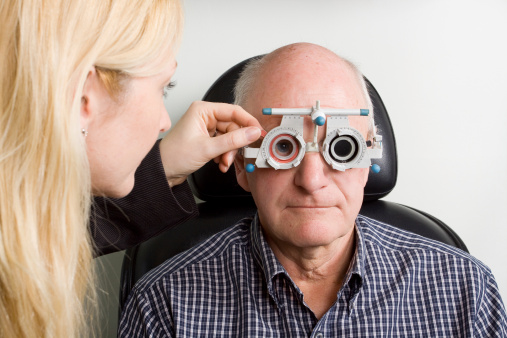Double vision, also called diplopia, causes a person to see two images of a single object. There are two types of double vision: monocular and binocular.
- Monocular diplopia is double vision in only one eye. The double vision continues even when the other eye is covered.
- Binocular diplopia is double vision related to a misalignment of the eyes. The double vision stops if one of the eyes is covered.
Causes
There are many potential causes for double vision, including:
- Astigmatism — This is an abnormal curvature of the front surface of the cornea.
- A dislocated lens — The ligaments that hold the lens in place are broken, and the lens moves out of place or wiggles. This can be caused by trauma to the eye or a condition known as Marfan’s syndrome. This can occur to both the natural lens or an artificial lens placed during cataract surgery.
- Pterygium — This is a thickening of the conjunctiva, the thin mucous membrane that lines the inner surface of the eyelids and the whites of the eyes. The thickening extends to the cornea, the clear part of the surface of the eye.
- Keratoconus — The cornea gradually becomes thin and cone-shaped.
- Cataracts — The lens gradually becomes less transparent. Risk factors include being older than 65, having eye trauma or long-term diabetes, smoking, using steroid medications or having radiation treatments.
- A mass or swelling in the eyelid — This condition can press on the front of the eye.
- Dry eye — Your eyes do not produce enough tears.
- Some retinal problems — Double vision can happen when the surface of the retina is not perfectly smooth, which can have a variety of causes.
- Strabismus — This is a childhood misalignment of the eyes that affects about 4% of children younger than age 6.
- Damage to nerves controlling the extraocular muscles — Nerves can be injured by brain damage caused by infection, multiple sclerosis, stroke, head trauma or a brain tumor, especially a tumor located at the lower back portion of the brain. A tumor growing inside the eye socket or trauma to the eye socket can damage a nerve anywhere along its route to the eye muscles.
- Diabetes — This disease can lead to problems with the nerves that control eye muscle movements. Sometimes this can happen before the person is aware that he or she has diabetes.
- Myasthenia gravis — This is a neuromuscular illness that causes the body’s muscles to tire easily and become weak. It occurs because the body’s immune system mistakenly attacks the places where nerves transmit impulses to muscles, telling the muscles to contract.
- Graves’ disease — This is the most common cause of an overactive thyroid (hyperthyroidism). Some people with Graves’ disease develop double vision due to swelling and thickening of the muscles that move the eyes within the eye socket.
- Trauma to the eye muscles — The muscles of the eye socket can be injured by facial trauma, especially by a fracture of the thin bones of the eye socket.
Symptoms
The only symptom is seeing two images of a single object.
Treatment
Treating double vision depends on its cause. For example, people with astigmatism that causes double vision can wear special contact lenses. Sometimes, simply updating your prescription eyeglasses takes care of the problem. Surgery is used to treat cataracts and pterygium, and surgery on the eye muscles can treat certain types of double vision. Often, adjustable stitches are used so that the position of the eyes can be fine-tuned a few hours after the surgery. That way, the patient is alert for the adjustment and can report whether the double vision is gone. Prisms also may be used in the glasses to fine-tune the surgery by moving the image seen with one eye to coincide with the other eye.
For children with strabismus, treatment includes wearing prescription eyeglasses, prism vision therapy to train the eyes to align properly, or surgery. Double vision caused by a medical or neurological disease may improve by treating the disease. Eye doctors may consider other strategies to help improve eye movements. Injections of botulinum toxin (Botox) can weaken strong eye muscles opposite the weakened one to help balance vision.
